November 17, 2016
by Carole Zangari -
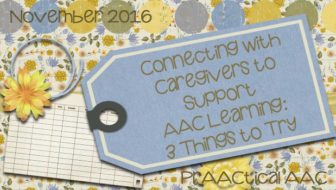
One of the best things about providing AAC services in a university-based clinic is that we have regular contact with parents and other caregivers. That gives them the opportunity to observe the session, or, better yet, become an active participant. This allows us to talk to them about issues with the AAC system and help them develop the skills and routines to support AAC learning outside the therapy session. Most practitioners, however, don’t have this luxury. How can we impact AAC use outside of therapy and the classroom when we have infrequent face-to-face time with families and other caregivers? Here are some things to try. Video: Make a short screencast using free tools (like Jing, from Techsmith). In less than 10 minutes, you can make a recording of your computer screen and narrate it with implementation tips and information, then upload it, and share the link with families. For more... [Read More...]
Filed under: Featured Posts, PrAACtical Thinking
November 15, 2016
by Carole Zangari -

Looking for a handy guide to help families who are new to communication disability get familiar with visual supports for communication? In today’s post, we share a wonderful booklet intended just for that purpose. Australian SLP Dolly Bhargava created this book, Getting Started: Using Visual Systems to Promote Communication, with support from the School for Parents and the Non Government Centre Support for Non School Organisations of Western Australia. You can see the accompanying video here.
Filed under: Featured Posts, PrAACtical Thinking
November 10, 2016
by Carole Zangari -

We’re excited to welcome back SLPs Lori Sanzeri and Chelsea Collins, creators of Core City, to tell us more about implementing this approach. They both work for the NYC Department of Education and created Core City to promote classroom-wide support of AAC. Last month, they introduced us to Core City. In this post, they share some of the ways that they get everyone involved in using and teaching AAC. STAFF TRAINING The most difficult part of training all staff is finding the time. We are fortunate to have a supportive administration that understands the importance of communication and works to find time to allow us to meet for professional development. If you are not afforded this time, our experience has shown us that the most successful staff training occurs by us modeling our strategies while we are working with the children in the classroom. We encourage the following strategies to... [Read More...]
Filed under: Featured Posts, PrAACtical Thinking
Tagged With: classroom, school, staff training, teaming
November 7, 2016
by Carole Zangari -
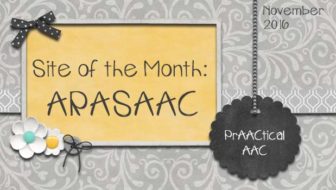
Symbols, templates, software, tools, and more. That’s what you’ll find on the November PrAACtical Site of the Month: ARASAAC, the Aragonese Portal of Augmentative and Alternative Communication. Supported by the Department of Education, Culture and Sports of the Aragonese Government and the General Directorate of Innovation, Equality and Participation, this award-winning site has been serving the AAC community for over two decades. They may be best known for the picture symbols that they share so freely, which allows professionals, users of AAC, and families to create free resources in Catalan, Euskera, English, French, German, Italian, Galician, Portuguese, Spanish, and more. The online tools section has a variety of things to explore including tools to make communication boards, animations (gifs), schedules and calendars, custom symbols, and games. There are also wonderful resources for Spanish Sign Language in pictures and videos. There is also a Materials Exchange section where you can download communication... [Read More...]
Filed under: Featured Posts, PrAACtical Thinking
Tagged With: AAC Resources, app, download, software
November 3, 2016
by Carole Zangari -
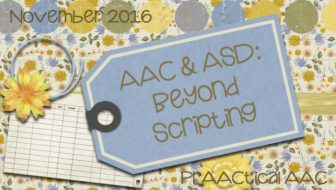
Today, we welcome Dr. Kimberly Ho, SLP and Director of Speech, Language and AAC Services at Confidence Connection in Needham, Massachusetts. In this post, she discusses how professionals in her organization are supporting AAC learners with autism on the journey toward flexible, generative language. I am the Director of Speech, Language and AAC Services at an ABA clinic, so naturally we serve many individuals with Autism Spectrum Disorder (ASD) of all ages. A vast number of learners with ASD can speak, but their speech is not functional to meet their communication needs. We have begun to provide word-based AAC systems for these students to move beyond scripting. Many individuals with ASD “script.” That is, they may not produce novel utterances, but rather chunks of phrases and sometimes entire sentences they have memorized. Sometimes this scripting is based on a character from a TV show or movie. Other times the script has been memorized in... [Read More...]
Filed under: Featured Posts, PrAACtical Thinking
Tagged With: ASD, scripting
October 31, 2016
by Carole Zangari -
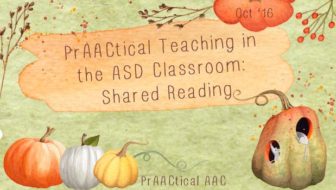
We are pleased to have a return visit from special educators Lauren Pawlowski and Amy Devin with ideas for supporting AAC learners in the classroom. Amy and Lauren, who work in the public school system in Michigan, taught in resource rooms for years and have been teaching in self‐contained ASD elementary classrooms since 2009. At that time, there were few classrooms who were integrating core language instruction, but they didn’t let that stop them. Currently, they use manual communication boards, large instructional core boards, and individual AAC devices with their students. They are passionate literacy teachers and, in today’s post, tell us about their approach to shared reading lessons. Their video is chock full of tips to help you make these lessons successful. Enjoy! Shared Reading: It’s Not What They Know, It’s What They THINK! Happy Fall AAC users and facilitators! This month we would like to share some of our tips for... [Read More...]
Filed under: Featured Posts, PrAACtical Thinking
Tagged With: ASD, education, implementation ideas, shared reading
October 27, 2016
by Carole Zangari -
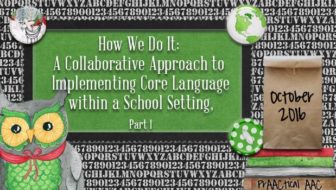
Nothing makes us smile like seeing teams in which professionals serving students with AAC needs work together to ensure that those students can use and grow their language skills. In this guest post, we learn about an approach that has worked for one such team, Lori Sanzeri and Chelsea Collins. Lori Sanzeri, MA CCC-SLP, TSHH, received her B.S. in Speech Language Pathology from SUNY Cortland in 2003 and M.A. from St. John’s University in 2009. She has worked for the NYC Department of Education since 2003 and teaches AAC and phonetics at St. John’s University. Chelsea Collins, MS CCC-SLP, TSSLD, received her B.S. in Special Education from Seton Hall University in 2009 and M.S. in Communicative Sciences and Disorders from New York University in 2012. She has worked for the NYC DOE since 2012 and specializes in AAC and early intervention. They are on Instagram as @thelanguageladies and have a Facebook page as... [Read More...]
Filed under: Featured Posts, PrAACtical Thinking
Tagged With: A Year of Core Words, classroom, school
October 26, 2016
by Carole Zangari -

And just like that, we’re ready to say goodbye to October. It’s been a great month of AAC Awareness events and activities (whew!), and now we are prepping for November. Looking for some ways to help your AAC learners become more competent in using core words? Need to get staff on board with modeling core vocabulary? Trying to get familiar with where core words are stored in a particular SGD or AAC app? Here’s an approach you may want to try: Choose a dozen or so core words to focus on each month. In previous years, we shared lists of some core words to help you do just that. 2013: A Year of Core (12 words/month) 2014: A(nother) Year of Core (16 words/month; Note: These are different than the core words covered in 2013) Those posts have links to downloadable grids with the core words for each month that can be used... [Read More...]
Filed under: Featured Posts, PrAACtical Thinking
Tagged With: A Year of Core Words, Another Year of Core Words, Books, Calendar, download
October 24, 2016
by Carole Zangari -
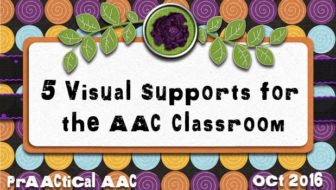
Looking for some additional ways to support learners with AAC needs in educational settings? Here are some visual supports that you may want to explore. Emergency Drills from The Success Box Morning Meeting Binder from Central/South AT Center Social Narratives and Other Visual Supports by SET-BC “When I’m Upset” by File Folder Heaven Tri-fold Displays with for conversation and behavior regulation by TASN
Filed under: Featured Posts, PrAACtical Thinking
Tagged With: classroom, visual support
October 20, 2016
by Carole Zangari -

Shared book reading is a great way to get families involved in building language and AAC skills. Today we’re back with another AT Recipe for Success from SLP Sara Barnhill and the AT Team at Children’s Hospital of Richmond at VCU. They’ve created several extension activities based on the book, Sometimes I Feel Sunny, to help families have fun and build AAC skills at the same time. As a member of the AT Core team, Sara is involved in AAC evaluations and therapy in the hospital’s clinics, out-patient program and Transitional Care Unit. CHoR’s AT Program is one of few comprehensive AT programs in Central Virginia. Their program provides AT evaluations, equipment and training to people of all ages, enabling children and adults with disabilities to function more independently. CHoR’s AT team consists of four SLPs, two OTs, one PT, and one Therapy Practice Assistant. In addition to completing transdiciplinary evaluations and treatments, CHoR’s AT team is... [Read More...]
Filed under: Featured Posts, PrAACtical Thinking









